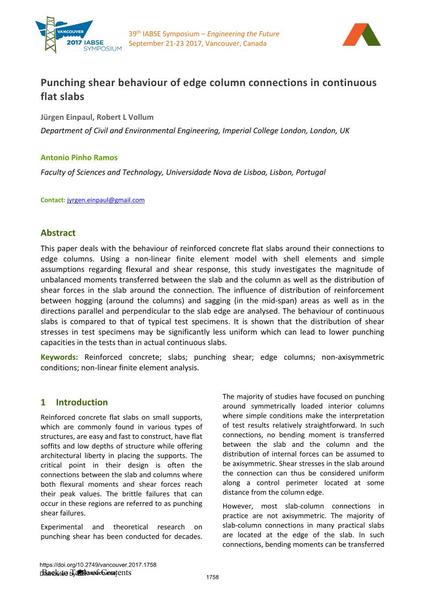Punching shear behaviour of edge column connections in continuous flat slabs

|
|
|||||||||||
Détails bibliographiques
| Auteur(s): |
Jürgen Einpaul
(Department of Civil and Environmental Engineering, Imperial College London, London, UK)
Robert Vollum (Department of Civil and Environmental Engineering, Imperial College London, London, UK) António Ramos (Faculty of Sciences and Technology, Universidade Nova de Lisboa, Lisbon, Portugal) |
||||
|---|---|---|---|---|---|
| Médium: | papier de conférence | ||||
| Langue(s): | anglais | ||||
| Conférence: | IABSE Symposium: Engineering the Future, Vancouver, Canada, 21-23 September 2017 | ||||
| Publié dans: | IABSE Symposium Vancouver 2017 | ||||
|
|||||
| Page(s): | 1758-1765 | ||||
| Nombre total de pages (du PDF): | 8 | ||||
| Année: | 2017 | ||||
| DOI: | 10.2749/vancouver.2017.1758 | ||||
| Abstrait: |
This paper deals with the behaviour of reinforced concrete flat slabs around their connections to edge columns. Using a non-linear finite element model with shell elements and simple assumptions regarding flexural and shear response, this study investigates the magnitude of unbalanced moments transferred between the slab and the column as well as the distribution of shear forces in the slab around the connection. The influence of distribution of reinforcement between hogging (around the columns) and sagging (in the mid-span) areas as well as in the directions parallel and perpendicular to the slab edge are analysed. The behaviour of continuous slabs is compared to that of typical test specimens. It is shown that the distribution of shear stresses in test specimens may be significantly less uniform which can lead to lower punching capacities in the tests than in actual continuous slabs. |
||||
